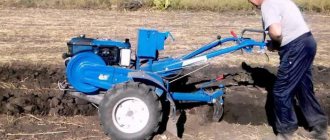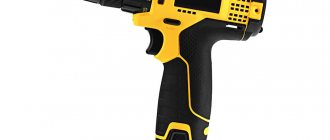Motoblocks today are widespread among both farmers and owners of summer cottages. This is a very convenient and relatively inexpensive technique that allows you to perform a wide range of agricultural operations. Thanks to their versatility and unpretentiousness, walk-behind tractors enjoy deserved popularity among users. In the article we will describe the main characteristics of this technique and the features of choice depending on the requirements put forward. We will place special emphasis on real reviews from owners.
What is a walk-behind tractor
The walk-behind tractor is a mechanized unit equipped with an engine and a pair of wheels. Thanks to this, the unit can move independently on any type of hard and ground surfaces. Walk-behind tractors are often confused with cultivators. The main difference between a motor cultivator is that it moves due to the cutter. Standard cultivator models are not equipped with wheels. Therefore, they can be used exclusively for soil cultivation.
Unlike a cultivator, a walk-behind tractor is successfully used for a number of different operations. The unit is pre-equipped with additional equipment (mower, pump, plow, etc.). Another advantage of the walk-behind tractor is the ability to use it to transport materials, tools, agricultural products, etc. For this, it is advisable to use a trailer. Most walk-behind tractors can successfully transport loads weighing approximately 5 times their own weight.
The walk-behind tractor usually comes with a cultivator cutter and a pair of wheels. The remaining equipment must be purchased separately. When choosing a walk-behind tractor, it is advisable to clearly understand for what purposes it will be used. This will allow you to select the most optimal unit model.
How did the rating of the best motor cultivators come about?
We warn you in advance that our site is not an advertising site and does not promote a particular product. All walk-behind tractors that will be on our list of the best units were selected impartially and on merit. We used the principle - we take it as for ourselves. What then influenced the selection criteria? These are 4 factors:
- Reviews from owners of motor cultivators. First of all, you can judge a product when you try it. For a walk-behind tractor, everything is exactly the same. Agree that using this or that technique over time, you will learn all its pros and cons. By leaving a review, you help others review the product. This is practice, it is better than the theory and opinion of sellers or advertising. Therefore, user reviews come first. But on the other hand, the list may include the most common devices, and good new products may not be noticed. That's why point #2 exists.
- Technical characteristics of walk-behind tractors. Thanks to them, it is possible to identify high-quality new products available in Russia, which landowners have not yet had time to “test.” Monitoring of similar equipment from the manufacturer was carried out, with ready-made reviews. We looked at engines, build quality and more.
- Functionality and cost of walk-behind tractors. Thanks to them, we excluded motor cultivators, which do not quite fit into the realities of the Russian standard of living. After all, you must agree that buying a walk-behind tractor, the price of which is comparable to the price of a good car, is irrational. Despite the fact that functionality, engines and build quality may be at an average level.
- Availability of purchase. Why talk a lot about a high-quality walk-behind tractor that is simply impossible to purchase in our country? We are making this list for people who want and will be able to buy a walk-behind tractor in our country.
Thanks to these four criteria, we have compiled a list of the best walk-behind tractors to help you get acquainted with the product and choose the one that is worth it.
Types of walk-behind tractors
Walk-behind tractors vary in power, weight, and engine type—gasoline or diesel. Each motor has its own characteristics, advantages and disadvantages.
Gasoline walk-behind tractors
According to reviews and sales statistics, walk-behind tractors with gasoline engines are the most popular. The following advantages can be highlighted:
• low price; • low engine noise; • the engine starts quickly, which can be especially important in our climatic conditions.
There are also disadvantages compared to diesel engines:
• lower efficiency; • less engine life; • worse endurance.
Gasoline engines are widely installed on light and medium-weight walk-behind tractors. When processing large areas, their capabilities may not be enough. This is especially true for virgin lands and other difficult-to-cultivate soils.
Diesel walk-behind tractors
Diesel units have more advantages:
• high efficiency; • long service life (about twice as long as gasoline engines), the best models have more than 3000 hours; • low fuel consumption; • high efficiency; • high traction forces at low speeds, which facilitates plowing of virgin lands and heavy soils; • possibility of processing large areas; • reliability and durability.
The main disadvantage is the higher price. Despite the cost-effectiveness of such equipment, most buyers still prefer gasoline units. This is explained by lower prices and the greater popularity of light and medium models.
Advantages and disadvantages
Advantages:
- high-quality materials and assembly;
- no harmful emissions;
- low fuel consumption;
- sustainability;
- quick execution of various agricultural tasks;
- long service life;
- high efficiency.
Flaws:
- noisy work;
- difficulty in transportation;
- poor starting in winter;
- low maneuverability.
Classification of walk-behind tractors by weight and power
Walk-behind tractors on the market are usually divided into three groups according to their weight and engine power:
1. Lungs. 2. Average. 3. Heavy.
Let us immediately note that this classification is quite conditional. Different sources indicate different criteria for classifying walk-behind tractors into one group or another depending on its mass or engine power. This is due, among other things, to the different efficiency of motors from different manufacturers, and the design features of a particular model. A walk-behind tractor with a lower rated power may be more productive than a heavier and more powerful unit.
Light walk-behind tractors
Typically, walk-behind tractors weighing up to 80 kg, equipped with engines with a power of up to 6–7 hp, are considered light. This group of equipment includes the heaviest motor cultivators with 4–5 hp motors. and the possibility of equipping with wheels.
Lightweight walk-behind tractors are suitable for cultivating plots of 30–40 acres. Since their service life and reliability are not very high, it is undesirable to work on such units for a long time without interruption. This may cause the engine to overheat.
With light walk-behind tractors, you can use additional equipment that does not require high power and traction, such as mowers, hillers, etc. With heavier attachments, such units will not show good performance.
Such walk-behind tractors are not suitable for plowing virgin lands and heavy soils. But they will work well on lighter soils such as peat.
Medium walk-behind tractors
This group includes units weighing 80–120 kg. They are equipped with engines with a power of approximately 6–7 to 9–10 hp. Most models are equipped with gasoline engines, but there are also diesel options.
Such walk-behind tractors are designed for the use of a variety of attachments and have fairly good functionality. They allow you to transport up to 500 kg of cargo. They can be successfully used as pumps, electric generators, etc.
For processing areas of up to 60 acres, gasoline walk-behind tractors with a power of about 9 hp or diesel 6–7 hp will be effective. On diesel units with a power of 8–10 hp. can be processed up to 1 ha.
Medium walk-behind tractors cope well with almost any type of soil cultivation: plowing, harrowing, cultivation, hilling, sowing.
Heavy walk-behind tractors
Models weighing more than 120 kg are usually classified as heavy. The weight of such machines can reach 350 kg. They are suitable for cultivating areas larger than a hectare. The most productive walk-behind tractors can be used on areas of 3–5 hectares. Engine power - from 9 hp. and higher, up to 15–16 hp. The vast majority of heavy units are equipped with diesel engines.
Due to its heavy weight, such a walk-behind tractor ideally plows virgin soil. Such models are designed for use on farms. You can work on them for a long time without interruption, they have a high service life and reliability. Heavy walk-behind tractors are well suited for transporting goods.
Specifications
| Parameter | Description |
| engine's type | 4-stroke petrol |
| Engine power | 4-7.0hp |
| Engine capacity | 160-198cm³ |
| Fuel tank volume | 3.6l |
| Processing width | up to 100cm |
| Processing depth | up to 32cm |
| Clutch | belt |
| Gearbox | chain |
| Pneumatic wheels | 4.00-8 |
| Number of speeds | 4 forward/2 reverse |
| Milling cutter diameter | 30cm |
| Milling speed | up to 156 rpm |
| Connecting an active hitch | pulley |
| Weight | 40-130 kg |
Attachments
Walk-behind tractors perform a wide range of agricultural operations, including soil cultivation, plowing, harrowing, hilling, weeding, mowing, sowing, harvesting, etc. To perform all these operations, special additional equipment is used such as seeders, harrows, etc.
In addition to purely agricultural operations, walk-behind tractors can also be used for transporting goods and removing snow, as electric generators and pumps.
Various models are equipped with a certain range of branded attachments. Usually only wheels and cutters for cultivation are supplied in the kit. Everything else should be purchased if necessary. Therefore, even when choosing a model, you need to decide for what functions the walk-behind tractor will be used.
In addition to branded additional equipment, you can often use equipment from other brands and even those made independently. After all, nothing will prevent you from transporting cargo on almost any type of trailer of suitable size.
To operate attachments, the walk-behind tractor is equipped with a power take-off shaft (abbreviated as PTO). Pumps, generators, seeders, etc. are connected to this shaft.
What to choose from heavy Russian-made walk-behind tractors
Two units can claim first place in the series of heavy machines - the Foreman GT80RDK and traditionally the Neva MB 23S 9.0. Both Russian-made units are very similar in layout and technical characteristics. But on the field, the models behave completely differently. The fairly large weight is compensated by powerful engines.
For the Foreman, this is a single-cylinder diesel engine made in China, with a power of nine horses and a diesel fuel consumption of just over one liter per hour. The 9 liter tank allows you to work for a full working day at one gas station. The Russian-made transmission and gearbox do not provide a harrow grip of more than a meter; the plowing depth is 20-25 cm. But the Foreman does an excellent job as a transport and as a means of cultivating light soils, especially since in growing vegetables and grain crops plowing is only 23-25 cm. 26% of all hard work on earth.
The Neva MB23S -9.0 is equipped with a nine-horsepower gasoline engine produced by the Subaru Corporation; the engine is powerful, torquey, but very demanding on fuel quality. The developers eliminated most of the errors made in the production of walk-behind tractors, and made the Russian Neva 23 one of the best tools for plowing land and transporting goods.
Second place rightfully belongs to the Belarus-09-N machine produced by the Minsk Tractor Plant. If the production of the walk-behind tractor were entirely Russian, then this unit could claim first place in most ratings. The production and service of Belarus - 09 is carried out by professional tractor manufacturers, which means that the designers know much more about the problems and often solve them more competently.
It is noteworthy that the development of Belarus was carried out on the basis of the concept of maximum accessibility of all components and mechanisms for repair; this greatly simplifies the operation and production of the unit.
The walk-behind tractor is equipped with a Honda GX270 gasoline engine with nine horses. The Japanese-made engine is famous for its unique reliability and endurance. Traditionally, a lot of attachments are produced for the Belarusian-Russian walk-behind tractor, even mobile circular saws, which makes it the most convenient and versatile in using the capabilities of the power take-off shaft.
Third place remains with the Ugra NMB1N10 walk-behind tractor. Production of Ugra N10 is established in Kaluga. Today it is the most popular and popular Russian-made walk-behind tractor. The design of the device uses a gasoline engine produced by Subaru with a power of 7 hp. In fact, the Russian Ugra walk-behind tractor is an intermediate version between the Neva 23 and the light Luch or Salyut. But the weight of the walk-behind tractor at 90 kg has clearly become excessive for such a machine.
It is worth noting the competent layout of the unit, but still the walk-behind tractor produced by Kaluga engine builders turned out to be too complex and “crude” in production. At one time, deficiencies and quality of DM engines forced Red October to abandon Kaluga engines.
Incorrect balancing of the Ugra engine led to the appearance of noticeable vibrations, and errors in the clutch operation led to the appearance of the well-known “tearing” start, that is, it is quite difficult to move off the walk-behind tractor without a strong jerk.
Tips for choosing
When choosing a walk-behind tractor, the following criteria should be taken into account:
1. The area of the area to be processed. 2. Soil type (virgin soil, heavy or light soil). 3. Types of work that the walk-behind tractor will perform. 4. The range of necessary additional equipment, the presence of a PTO, the functionality of the model. 5. Width and depth of cultivation. 6. Value for money, efficiency, productivity, reliability. 7. Possibilities for warranty and post-warranty service, availability of a service network, availability and cost of parts. 8. Reviews from real users.
Which petrol walk-behind tractor is better to buy?
The review of units of light, medium and heavy classes with engines of different power, functions and characteristics presented for consideration will help the buyer to significantly narrow the search and understand which is the best gasoline walk-behind tractor. After the experts were able to determine the pros and cons of each nominee, the following conclusions can be drawn:
- The highest productivity is Weima WM1100BE (wheels 5x12);
- The most functional is Mobile K MKM-3 PRO;
- Easy to use and accessible - Patriot Pobeda;
- Best price and good quality – Huter GMC-7.0M;
- Availability of attachments – KaDvi Ugra NMB-1N7;
- The largest number of cutters is Daewoo Power Products DATM 80110.
If you have come to the conclusion that you need an assistant in the yard, then it is important to clearly define the selection criteria, namely: for what purpose is it needed, what work will you entrust to him, take into account when choosing the volume and area of the territory to be cultivated and the condition of the soil . For the rest, feel free to rely on our rating of walk-behind tractors for 2021.
The best walk-behind tractors according to owner reviews
Based on the country of origin, all walk-behind tractors can be fairly roughly divided into 3 groups. The first is models from well-known manufacturers from Germany, the Netherlands, and Korea. According to reviews from owners, such units are distinguished by high quality, performance, and reliability. The disadvantages are also clear - the high price and possible problems with maintenance, purchasing parts, etc.
The domestically produced walk-behind tractors, to which Belarusian equipment is associated, are somewhat inferior in quality and reliability. Among the advantages are the price/quality ratio, the availability of inexpensive spare parts and components, and unpretentiousness.
Chinese models stand out among the cheapest on the market. Among them there is also quite high-quality equipment, which is noticeably inferior to Russian models in terms of reliability and durability. The main advantages are low prices and a wide range.
Patriot Kaluga
Lightweight walk-behind tractor for small summer cottages. Weight 75 kg, pneumatic wheels, PTO, 2 forward speeds, 1 reverse. According to reviews, the unit is very easy to work with, especially for people with small dimensions. Handles simple soils well.
Neva MB-2
This walk-behind tractor has been produced in various modifications for more than 30 years. The legendary unit is highly reliable, unpretentious, and is well adapted to our conditions. Thanks to the availability of spare parts, servicing the walk-behind tractor will not be a problem. Several options are available with different engines (including Subaru and Honda) and minor differences in functionality.
The manufacturer produces both small and medium walk-behind tractors weighing from 70 to 105 kg. The heaviest in the line are diesel modifications of the MB-23 model weighing up to 115 kg.
Weima WM1100A
Chinese-made diesel walk-behind tractor weighing 115 kg. Productive, with reinforced gear reduction and reduction gearbox. It has wide functionality; you can connect a variety of attachments (pump, snow blower). According to reviews, it can transport more than a ton of cargo in a trailer.
Two words about engines
To say that Russian engines for walk-behind tractors are not produced in sufficient quantities is to say nothing. Attempts by the Krasny Oktyabr machine-building association, together with Kaluga and Ufa engine manufacturers, to make a domestic engine for a walk-behind tractor finally froze after Chinese clones of American and Japanese gasoline engines and diesel engines crushed almost 70% of the Russian market.
The last one who tried to produce walk-behind tractors with a Russian engine was the same. His Neva walk-behind tractor with the Russian DM1K engine is produced in almost very small batches for the Neva MB2K, and even spare parts for it are gradually becoming a problem. The gasoline engine turned out to be very unpretentious in maintenance; it could consume Russian A92 gasoline, even of the most mediocre quality. But the power is 7.5 hp. there is no longer enough for work, and more powerful Russian models have never been put into production.
Today, most of the good Russian units, Neva, Belarus, Krot, produced at one time with domestic engines, are being modernized by their owners to a new element base. Russian engines and gearboxes are being replaced by Chinese Lifans, American Briggs and Japanese Subarus and Hondas. Moreover, the average cost of a kit for replacing a Russian-made engine with a Chinese unit will cost only 1,500 rubles.
Moreover, most commercial companies involved in the sale of equipment, engines and spare parts for walk-behind tractors offer adapted versions of the best-in-class HONDA GX200 for direct installation on most Russian vehicles.
"Salyut 100 BS-V" and "UGRA NMB 1N10"
Heavy walk-behind tractors are distinguished by high strength and good technical characteristics. The Ugra walk-behind tractor is produced in Kaluga. It has increased stability. Suitable for plowing the soil, cleaning the site and cultivating. Additionally, you can use a milling cutter, plow, coulter, grouser and extension.
The advantages of the unit include ignition interlock and low noise level.
Model specifications:
- engine – single-cylinder petrol with a capacity of 7 liters. With. ;
- tank capacity – 3.6 l;
- travel speed – 8 km/h;
- weight – 90 kg.











